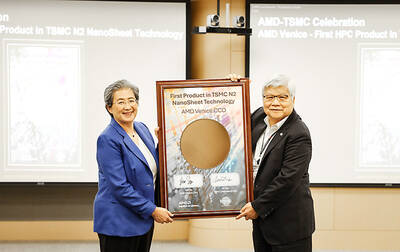The days of a “free lunch” are over for Asia’s banks, which face an intensifying threat from slowing economic growth and competition with technology firms, according to McKinsey & Co.
After years of rapid expansion, banks in the region are now seeing their revenue and profit growth slow and global market share shrink, the New York-based consultancy wrote in a report.
Tighter margins, declining asset quality and rising capital costs are putting pressure on lenders to partner or merge to boost productivity and scale.
“Many banks will struggle as the storm worsens,” McKinsey wrote. “The road ahead is difficult, and less efficient banks will disappear.’’
Banks will need to use technology to improve efficiency and fend off the threat from “digital attackers” such as Alibaba Group Holding Ltd (阿里巴巴) and Google, the report said.
Fintech companies might extend their ability to collect deposits and make loans, further eroding banks’ market share, it said.
Such firms are also squeezing margins of traditional lenders because they do not have to manage costly brick-and-mortar branches, said Joydeep Sengupta, one of the report’s authors and a senior partner at McKinsey in Singapore.
Asia-Pacific banks generated 37 percent of global pretax industry profit last year, down from 49 percent in 2012, the report showed.
It attributed the decline to slower growth and a recovery in other regions following the global economic crisis.
Lenders that adapt quickly to the changing industry could reap rewards, the report said.
It identified four areas where such banks could capture US$100 billion in new revenue annually if they adopt the right digital strategies: wealth management, retail banking, small-business lending and transaction banking.
“To pursue these opportunities, banks must beat the attackers at their own game” by developing digital platforms and analytics that track customers’ decisions in real time, the report said.
Recent innovations in automation, artificial intelligence and analytics might also give banks room to slash as much as 40 percent from operating costs, McKinsey said.
Such productivity gains are needed because of the region’s slower economic growth, it said.
“Multiple trends show clearly that the days of a free lunch and fast growth — especially for banks in emerging markets — are behind us,” the report said.

UNCERTAINTY: Innolux activated a stringent supply chain management mechanism, as it did during the COVID-19 pandemic, to ensure optimal inventory levels for customers Flat-panel display makers AUO Corp (友達) and Innolux Corp (群創) yesterday said that about 12 to 20 percent of their display business is at risk of potential US tariffs and that they would relocate production or shipment destinations to mitigate the levies’ effects. US tariffs would have a direct impact of US$200 million on AUO’s revenue, company chairman Paul Peng (彭雙浪) told reporters on the sidelines of the Touch Taiwan trade show in Taipei yesterday. That would make up about 12 percent of the company’s overall revenue. To cope with the tariff uncertainty, AUO plans to allocate its production to manufacturing facilities in

TAKING STOCK: A Taiwanese cookware firm in Vietnam urged customers to assess inventory or place orders early so shipments can reach the US while tariffs are paused Taiwanese businesses in Vietnam are exploring alternatives after the White House imposed a 46 percent import duty on Vietnamese goods, following US President Donald Trump’s announcement of “reciprocal” tariffs on the US’ trading partners. Lo Shih-liang (羅世良), chairman of Brico Industry Co (裕茂工業), a Taiwanese company that manufactures cast iron cookware and stove components in Vietnam, said that more than 40 percent of his business was tied to the US market, describing the constant US policy shifts as an emotional roller coaster. “I work during the day and stay up all night watching the news. I’ve been following US news until 3am

COLLABORATION: Given Taiwan’s key position in global supply chains, the US firm is discussing strategies with local partners and clients to deal with global uncertainties Advanced Micro Devices Inc (AMD) yesterday said it is meeting with local ecosystem partners, including Taiwan Semiconductor Manufacturing Co (TSMC, 台積電), to discuss strategies, including long-term manufacturing, to navigate uncertainties such as US tariffs, as Taiwan occupies an important position in global supply chains. AMD chief executive officer Lisa Su (蘇姿丰) told reporters that Taiwan is an important part of the chip designer’s ecosystem and she is discussing with partners and customers in Taiwan to forge strong collaborations on different areas during this critical period. AMD has just become the first artificial-intelligence (AI) server chip customer of TSMC to utilize its advanced

Six years ago, LVMH’s billionaire CEO Bernard Arnault and US President Donald Trump cut the blue ribbon on a factory in rural Texas that would make designer handbags for Louis Vuitton, one of the world’s best-known luxury brands. However, since the high-profile opening, the factory has faced a host of problems limiting production, 11 former Louis Vuitton employees said. The site has consistently ranked among the worst-performing for Louis Vuitton globally, “significantly” underperforming other facilities, said three former Louis Vuitton workers and a senior industry source, who cited internal rankings shared with staff. The plant’s problems — which have not